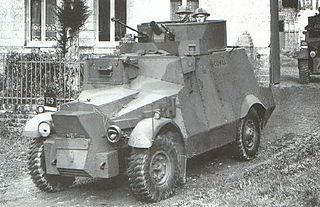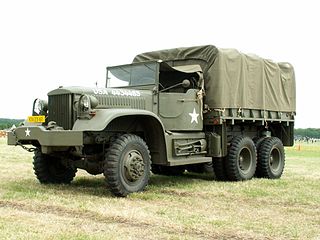
Associated Equipment Company (AEC) was a British vehicle manufacturer that built buses, motorcoaches and trucks from 1912 until 1979. The name Associated Equipment Company was hardly ever used; instead, it traded under the AEC and ACLO brands. During World War One, AEC was the most prolific British lorry manufacturer, after building London's buses before the war.

The Morris Commercial C8 FAT, commonly known as a (Beetle-back) Quad, is an artillery tractor used by the British and Commonwealth, during the Second World War. It was used to tow field artillery pieces, such as the 25-pounder gun-howitzer, and anti-tank guns, such as the 17-pounder.
Bedford Vehicles, usually shortened to just Bedford, was a brand of vehicle manufactured by Vauxhall Motors, then a subsidiary of multinational corporation General Motors. Established in April 1931, Bedford Vehicles was set up to build commercial vehicles. The company was a leading international lorry brand, with substantial export sales of light, medium, and heavy lorries throughout the world.

The Jeep Forward Control is a truck that was produced by Willys Motors, later named Kaiser Jeep, from 1956 to 1965. It was also assembled in other international markets. The layout featured a cab over design.

The Morris CS9/Light Armoured Car was a British armoured car used by the British Army in the Second World War.

Morris Commercial Cars Limited is a British manufacturer of commercial vehicles formed by William Morris, founder of Morris Motors Limited, to continue the business of E G Wrigley and Company which he purchased as of 1 January 1924.

The Diamond T Company was an American automobile and truck manufacturer. They produced commercial and military trucks.

The Ford Thames 400E is a commercial vehicle that was made by Ford UK and introduced in 1957. Production of the range continued until September 1965, by which time a total of 187,000 had been built. Publicity for the model included hiring the Cy Laurie band to make the promotional film short 'Band Wagon', in 1958, preserved in the 'Ford Film and Video Collection' at the National Motor Museum, Beaulieu

Canadian Military Pattern (CMP) trucks were mutually coherent ranges of military trucks, made in large numbers, in several classes and numerous versions, by Canada's branches of the U.S. 'Big Three' auto-makers during World War II, compliant to British Army specifications, primarily intended for use in the armies of the British Commonwealth allies, but also serving in other units of the British Empire.

The GMC CCKW, also known as "Jimmy", or the G-508 by its Ordnance Supply Catalog nr, was a highly successful series of off-road capable, 21⁄2-ton, 6×6 trucks, built in large numbers to a standardized design for the U.S. Army, that saw heavy service, predominantly as cargo trucks, in both World War II and the Korean War. The original "Deuce and a Half", it formed the backbone of the famed Red Ball Express that kept Allied armies supplied as they pushed eastward after the Normandy invasion.

The Bedford OY is an army lorry (truck) built by Bedford for the British Armed Forces and introduced in 1939. It was based on Bedford's O-series commercial vehicles with a modified front end and single rear tyres. It was designed for a 3-ton payload. The OYD was a general service vehicle, while the OYC was a tanker version for carrying water or petrol. These vehicles were widely used during, and after, World War II but were later superseded by the Bedford RL.

The Mack model EH trucks were a family of 4x2 trucks used by the US and British military before and during World War II. They were built in conventional and cab-over-engine models and were used as both trucks and semi-tractors. Originally a commercial design, in 1943 a military version became standard.

The M425 and M426 Tractor trucks (G671) were 5 ton (4,536kg) load rated 4x2 semi-tractors that were used from 1944 on by the US Army. They are famous for the use on the Red Ball Express from Normandy to the front, but were also used in the China Burma India Theater. After the war they were used in Europe, including during the Berlin Crisis, and in the Korean War.

Mack Trucks has been selling heavy duty trucks and buses to the United States military since 1911. Virtually every model has been used. The majority have been commercial models designed and built by Mack with their own components, but they have also designed and built military specification tactical trucks. The military vehicles are rated by payload measured in tons.

The 2+1⁄2-ton, 6×6 truck was a standard class of medium duty trucks, designed at the beginning of World War II for the US Armed Forces, in service for over half a century, from 1940 into the 1990s. Also frequently known as the deuce and a half, or just deuce, this nickname was popularized post WWII, most likely in the Vietnam war era. The basic cargo versions were designed to transport a cargo load of nominally 2+1⁄2 short tons over all terrain, in all weather. The 2+1⁄2-ton trucks were used ubiquitously in World War II, and continued to be the U.S. standard medium duty truck class after the war, including wide usage in the Korean and Vietnam Wars, as well as the first Gulf War.

The Diamond T 4-ton 6×6 truck was a heavy tactical truck built for the United States Army during World War II. Its G-number was G-509. Cargo models were designed to transport a 4-ton (3,600 kg) load over all terrain in all weather. There were also wrecker, dump, and other models. They were replaced by the M39 series 5-ton 6×6 trucks in the 1950s.

The Bedford MW was a general service truck used by the British Armed Forces during the Second World War.

Thames was a commercial vehicle brand produced by Ford of Britain.

The Bedford HC is a small commercial vehicle that was made by Bedford, beginning in 1938. The vehicle shared its running gear with the H-series Vauxhall 10-4 saloon. Production of civilian vehicles ceased during World War II with the HC van re-entering production for a little while following hostilities. The HC was later joined by the heavier duty Bedford JC, which was itself replaced by the higher-roofed Bedford PC after the war. With the arrival of the much more modern Bedford CA the by now outmoded PC was finally retired.

The Fordson WOT was a military truck produced by Ford of Britain in the Second World War. From 1939 to 1945, around 130,000 units were produced at the Ford Dagenham plant with almost half being the WOT2.




















